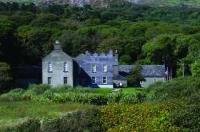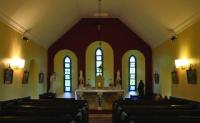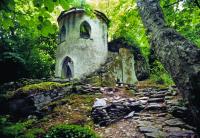Derrynane House, ‘Mecca of the lovers of liberty’
Published in 18th–19th - Century History, Features, Issue 5 (Sept/Oct 2010), Volume 18
Derrynane House from the south. (Eilíse McGuane)
Derrynane House, Co. Kerry, once known as Derrynane Abbey, was the ancestral home of Daniel O’Connell, one of the most celebrated figures in modern Irish history. From his infancy to his death in Genoa in 1847, Daniel and his family spent most of their summers at Derrynane. Described as the ‘Mecca of the lovers of liberty’, Derrynane is now a museum to the life and times of the Liberator and his family, and, along with some 300 acres of surrounding lands, makes up Derrynane National Historic Park.
The oldest part of the house was built by Daniel O’Connell’s grandfather, Captain John O’Connell, in 1702. The north-facing, two-storey house of 1702 was extended or replaced by the captain’s son, Dónal Mór, and this three-storey Georgian farmhouse survived until its demolition, owing to its bad structural condition, by the Office of Public Works (OPW) in the late 1960s: it is today marked out by paving in the courtyard. The house was subsequently owned by O’Connell’s uncle, ‘Hunting-Cap’ O’Connell, until it passed on his death to his nephew Daniel in 1825. At this time Daniel O’Connell greatly extended the house, with a spacious dining room and drawing room to the south, and a crenellated library wing to the east. The orientation of the main entrance was altered from the old approach from the north to the entrance visitors use today, which meets the house on the east.
Plantation and garden walks were laid out by the O’Connell family in the eighteenth and nineteenth centuries, principally north and west of the house. The Gothic Revival summerhouse in the gardens is directly associated with Daniel O’Connell, who built it as his study.

Interior of chapel. (Eilíse McGuane)
One of the most iconic features of the property is the private chapel added in 1844, following O’Connell’s release from prison after his conviction for conspiracy in relation to the banned Clontarf ‘monster meeting’ of 1843; this is linked to the main building by a single-storey passage entered from the courtyard to the east of the house. The single-cell chapel was roughly modelled on the ruined monastery chapel of nearby Abbey Island. Given Daniel O’Connell’s close link with Catholic Emancipation (1829), the Derrynane chapel has had an active conservation history involving many prominent religious figures. Indeed, it is believed that Pope Pius XII donated £100 to the conservation of Derrynane House and chapel.
No significant additions were made after O’Connell’s death and the house remained in the family’s possession until Daniel’s great-granddaughter, Fannie O’Connell, left the house owing to illness in 1958. The Derrynane Trust, founded in 1948, had already carried out conservation work on the chapel and house, and in 1964 the property was transferred to Bord Fáilte in order to retain it for posterity. The house was opened by President Éamon de Valera as a museum in 1967; three years later it was handed over to the OPW. Derrynane National Historic Park was officially opened by President Cearbhall Ó Dálaigh on the bicentenary of the birth of Daniel O’Connell in 1975.

Daniel O’Connell’s Gothic summerhouse. (OPW)
Derrynane House as seen today, following the restoration completed by the OPW in 1967, consists essentially of the south and east wings built by Daniel O’Connell in 1825 and the chapel of 1844. The surviving house contains the main entrance hall, with the dining room and study opening directly off it on the ground floor. At first-floor level, visitors can see the drawing room and the old library, now displayed as a bedroom. The chapel is also open to visitors. The house and national park are open to the public from April to November. HI
Eilíse McGuane is an architectural researcher working on Catholic estates in Munster. Series based on the National Inventory of Architectural Heritage’s ‘building of the month’, www.buildingsofireland.ie.


















